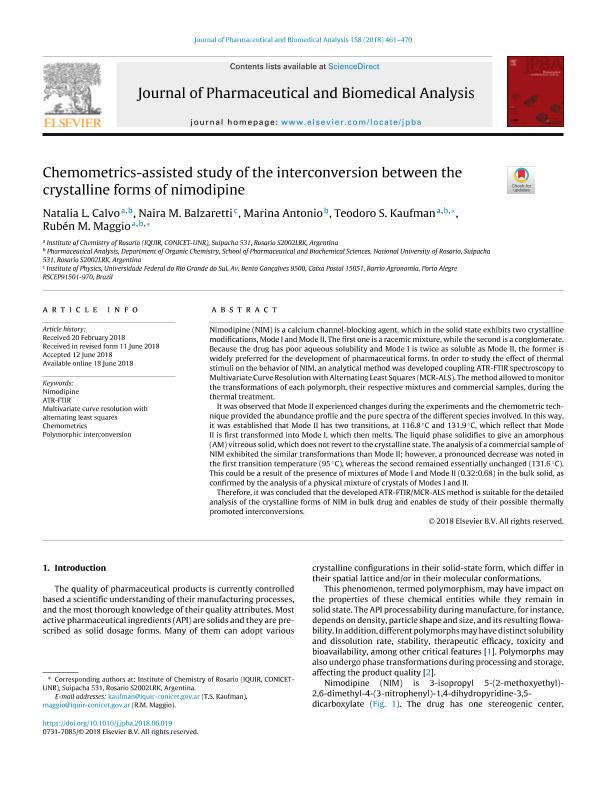Mostrar el registro sencillo del ítem
dc.contributor.author
Calvo, Natalia Lorena

dc.contributor.author
Balzaretti, Vilma Teresa

dc.contributor.author
Antonio, Marina

dc.contributor.author
Kaufman, Teodoro Saul

dc.contributor.author
Maggio, Ruben Mariano

dc.date.available
2019-10-22T18:03:26Z
dc.date.issued
2018-09
dc.identifier.citation
Calvo, Natalia Lorena; Balzaretti, Vilma Teresa; Antonio, Marina; Kaufman, Teodoro Saul; Maggio, Ruben Mariano; Chemometrics-assisted study of the interconversion between the crystalline forms of nimodipine; Elsevier Science; Journal of Pharmaceutical and Biomedical Analysis; 158; 9-2018; 461-470
dc.identifier.issn
0731-7085
dc.identifier.uri
http://hdl.handle.net/11336/86939
dc.description.abstract
Nimodipine (NIM) is a calcium channel-blocking agent, which in the solid state exhibits two crystalline modifications, Mode I and Mode II. The first one is a racemic mixture, while the second is a conglomerate. Because the drug has poor aqueous solubility and Mode I is twice as soluble as Mode II, the former is widely preferred for the development of pharmaceutical forms. In order to study the effect of thermal stimuli on the behavior of NIM, an analytical method was developed coupling ATR-FTIR spectroscopy to Multivariate Curve Resolution with Alternating Least Squares (MCR-ALS). The method allowed to monitor the transformations of each polymorph, their respective mixtures and commercial samples, during the thermal treatment. It was observed that Mode II experienced changes during the experiments and the chemometric technique provided the abundance profile and the pure spectra of the different species involved. In this way, it was established that Mode II has two transitions, at 116.8 °C and 131.9 °C, which reflect that Mode II is first transformed into Mode I, which then melts. The liquid phase solidifies to give an amorphous (AM) vitreous solid, which does not revert to the crystalline state. The analysis of a commercial sample of NIM exhibited the similar transformations than Mode II; however, a pronounced decrease was noted in the first transition temperature (95 °C), whereas the second remained essentially unchanged (131.6 °C). This could be a result of the presence of mixtures of Mode I and Mode II (0.32:0.68) in the bulk solid, as confirmed by the analysis of a physical mixture of crystals of Modes I and II. Therefore, it was concluded that the developed ATR-FTIR/MCR-ALS method is suitable for the detailed analysis of the crystalline forms of NIM in bulk drug and enables de study of their possible thermally promoted interconversions.
dc.format
application/pdf
dc.language.iso
eng
dc.publisher
Elsevier Science

dc.rights
info:eu-repo/semantics/openAccess
dc.rights.uri
https://creativecommons.org/licenses/by-nc-nd/2.5/ar/
dc.subject
ATR-FTIR
dc.subject
CHEMOMETRICS
dc.subject
MULTIVARIATE CURVE RESOLUTION WITH ALTERNATING LEAST SQUARES
dc.subject
NIMODIPINE
dc.subject
POLYMORPHIC INTERCONVERSION
dc.subject.classification
Química Analítica

dc.subject.classification
Ciencias Químicas

dc.subject.classification
CIENCIAS NATURALES Y EXACTAS

dc.title
Chemometrics-assisted study of the interconversion between the crystalline forms of nimodipine
dc.type
info:eu-repo/semantics/article
dc.type
info:ar-repo/semantics/artículo
dc.type
info:eu-repo/semantics/publishedVersion
dc.date.updated
2019-10-16T19:16:23Z
dc.journal.volume
158
dc.journal.pagination
461-470
dc.journal.pais
Países Bajos

dc.journal.ciudad
Amsterdam
dc.description.fil
Fil: Calvo, Natalia Lorena. Consejo Nacional de Investigaciones Científicas y Técnicas. Centro Científico Tecnológico Conicet - Rosario. Instituto de Química Rosario. Universidad Nacional de Rosario. Facultad de Ciencias Bioquímicas y Farmacéuticas. Instituto de Química Rosario; Argentina
dc.description.fil
Fil: Balzaretti, Vilma Teresa. Universidad Nacional de Rosario; Argentina
dc.description.fil
Fil: Antonio, Marina. Consejo Nacional de Investigaciones Científicas y Técnicas. Centro Científico Tecnológico Conicet - Rosario. Instituto de Química Rosario. Universidad Nacional de Rosario. Facultad de Ciencias Bioquímicas y Farmacéuticas. Instituto de Química Rosario; Argentina
dc.description.fil
Fil: Kaufman, Teodoro Saul. Consejo Nacional de Investigaciones Científicas y Técnicas. Centro Científico Tecnológico Conicet - Rosario. Instituto de Química Rosario. Universidad Nacional de Rosario. Facultad de Ciencias Bioquímicas y Farmacéuticas. Instituto de Química Rosario; Argentina
dc.description.fil
Fil: Maggio, Ruben Mariano. Consejo Nacional de Investigaciones Científicas y Técnicas. Centro Científico Tecnológico Conicet - Rosario. Instituto de Química Rosario. Universidad Nacional de Rosario. Facultad de Ciencias Bioquímicas y Farmacéuticas. Instituto de Química Rosario; Argentina
dc.journal.title
Journal of Pharmaceutical and Biomedical Analysis

dc.relation.alternativeid
info:eu-repo/semantics/altIdentifier/url/https://www.sciencedirect.com/science/article/pii/S0731708518304564
dc.relation.alternativeid
info:eu-repo/semantics/altIdentifier/doi/http://dx.doi.org/10.1016/j.jpba.2018.06.019
Archivos asociados
